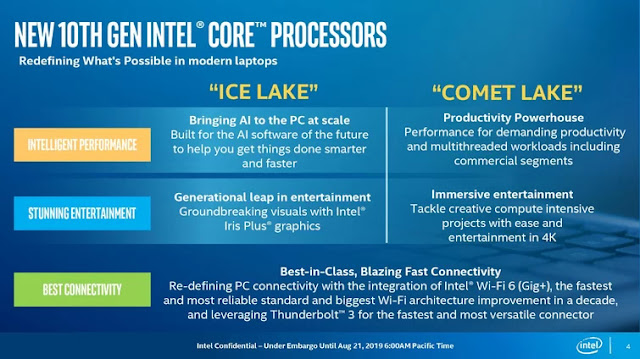 |
| Pic Source - Link |
Intel Unveils Comet Lake Processors, 14nm Chips Join 10nm in 10th-Gen Lineup. Today’s announcement focuses on its Comet Lake CPUs, resulting in even more Y- and U-series CPUs to decipher. All eight of these new 10th Gen processors use Intel’s 14nm process, not Ice Lake’s 10nm process, the new Intel Core i7-10710U is its first hexacore U-series processor, and it features 12 threads and a higher max clock speed than some of Intel’s Ice Lake processors.
Unlike the 10nm Ice Lake chips the Intel began shipping earlier this month, the eight new models come wielding the 14nm process. That creates a confusing mismatch in the company's 10th-Gen series, as the 10nm Ice Lake models come with a newer manufacturing process, architecture, and beefed up Gen11 graphics, while the 14nm Comet Lake chips come with the aging Skylake architecture and Gen 9.5 graphics. And they're all lumped under the 10th-Generation branding. via Techradar.
The new 14nm chips will lack the benefits that the 10nm chips have, though. On the whole, these likely won’t be as efficient nor will they tout the same kind of excellent battery life as machines that feature Ice Lake chips. None of them feature Intel’s Gen11 impressive integrated graphics, which it claims can handle some relatively smooth gaming at 1080p resolution. Comet Lake is instead using a previous version of its integrated graphics, as denoted by the lack of a “G” followed by a number in their model names. Basically, unless you buy a laptop that has dedicated graphics from AMD or Nvidia, these 10th Gen CPUs won’t be capable of a whole lot by themselves, depending on the games you like to play. via the verge
Ryan Smith of AnandTech also pointed out on Twitter that the new U-series chips will support fast LPDDR4x memory in laptops. So go on, Apple and other manufacturers, please leave DDR3 behind. Intel also deserves a nod for maintaining consistency across these new U- and Y-series chips with the same support for Thunderbolt 3 and Wi-Fi 6 found in other 10th Gen processors. The company’s press release states that some of these processors will appear in machines with the “Project Athena” sticker, which is its guarantee that they have been vetted and verified to last for nine hours.
In a bid to "simplify" the difference between the two types of processors, Intel points to the "G7" branding (which could also be G4) that denotes the level of Gen11 graphics, as the primary identifier for Ice Lake chips. That makes sense, as the Comet Lake chips don't come with Gen11 graphics and therefore do not have the "Gx" identifier, but that hardly helps the average consumer.
Intel says that they’ll be in machines by the time the holiday season rolls around. And while its more efficient, performant 10nm chips will land in pricier machines, these new processors will likely lead to an influx of slightly cheaper Ultrabooks, 2-in-1 laptops, and other slim form-factor PCs, which could even potentially include future Surface and MacBook products.
Unlike the 10nm Ice Lake chips the Intel began shipping earlier this month, the eight new models come wielding the 14nm process. That creates a confusing mismatch in the company's 10th-Gen series, as the 10nm Ice Lake models come with a newer manufacturing process, architecture, and beefed up Gen11 graphics, while the 14nm Comet Lake chips come with the aging Skylake architecture and Gen 9.5 graphics. And they're all lumped under the 10th-Generation branding. via Techradar.
The new 14nm chips will lack the benefits that the 10nm chips have, though. On the whole, these likely won’t be as efficient nor will they tout the same kind of excellent battery life as machines that feature Ice Lake chips. None of them feature Intel’s Gen11 impressive integrated graphics, which it claims can handle some relatively smooth gaming at 1080p resolution. Comet Lake is instead using a previous version of its integrated graphics, as denoted by the lack of a “G” followed by a number in their model names. Basically, unless you buy a laptop that has dedicated graphics from AMD or Nvidia, these 10th Gen CPUs won’t be capable of a whole lot by themselves, depending on the games you like to play. via the verge
Ryan Smith of AnandTech also pointed out on Twitter that the new U-series chips will support fast LPDDR4x memory in laptops. So go on, Apple and other manufacturers, please leave DDR3 behind. Intel also deserves a nod for maintaining consistency across these new U- and Y-series chips with the same support for Thunderbolt 3 and Wi-Fi 6 found in other 10th Gen processors. The company’s press release states that some of these processors will appear in machines with the “Project Athena” sticker, which is its guarantee that they have been vetted and verified to last for nine hours.
In a bid to "simplify" the difference between the two types of processors, Intel points to the "G7" branding (which could also be G4) that denotes the level of Gen11 graphics, as the primary identifier for Ice Lake chips. That makes sense, as the Comet Lake chips don't come with Gen11 graphics and therefore do not have the "Gx" identifier, but that hardly helps the average consumer.
Intel says that they’ll be in machines by the time the holiday season rolls around. And while its more efficient, performant 10nm chips will land in pricier machines, these new processors will likely lead to an influx of slightly cheaper Ultrabooks, 2-in-1 laptops, and other slim form-factor PCs, which could even potentially include future Surface and MacBook products.






